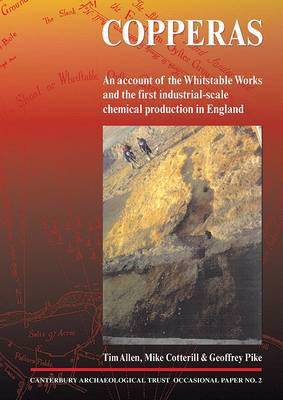
- Afhalen na 1 uur in een winkel met voorraad
- Gratis thuislevering in België vanaf € 30
- Ruim aanbod met 7 miljoen producten
- Afhalen na 1 uur in een winkel met voorraad
- Gratis thuislevering in België vanaf € 30
- Ruim aanbod met 7 miljoen producten
Zoeken
Copperas
An Account of the Whitstable Works and the First Industrial-Scale Chemical Production in England
T G Allen
€ 52,45
+ 104 punten
Omschrijving
In 1995 an extraordinary array of timber posts set in bright yellow mortar was exposed by marine erosion of the Tankerton foreshore at Whitstable, Kent. Canterbury Archaeological Trust, with the help of English Heritage and Canterbury City Council, later carried out a two-year investigation of these features and began research into what they could tell of the history of Whitstable. This publication describes how some of the remains were identified as part of a copperas works, representing unique evidence of the first major chemical industry to be established in England. The excavation report is followed by a description of the industrial process and the chemistry of copperas production, and outlines its important role in the development of the fertiliser and other modern chemical and pharmaceutical industries. This is followed by a comprehensive history of the copperas industry, describing its complex relationship with sixteenth- and seventeenth-century migrations from the Low Countries, and demonstrating how the industry was intrinsically linked with the new role of capital in the economy of late sixteenth-century England. A history of the works at Whitstable, their impact on the town and some of the families connected with the industry, makes strong use of documentary evidence and brings the account to its conclusion.
Specificaties
Betrokkenen
- Auteur(s):
- Uitgeverij:
Inhoud
- Aantal bladzijden:
- 64
- Taal:
- Engels
- Reeks:
- Reeksnummer:
- nr. 2
Eigenschappen
- Productcode (EAN):
- 9781870545082
- Verschijningsdatum:
- 1/12/2004
- Uitvoering:
- Paperback
- Formaat:
- Trade paperback (VS)
- Afmetingen:
- 209 mm x 293 mm

Alleen bij Standaard Boekhandel
+ 104 punten op je klantenkaart van Standaard Boekhandel
Beoordelingen
We publiceren alleen reviews die voldoen aan de voorwaarden voor reviews. Bekijk onze voorwaarden voor reviews.








